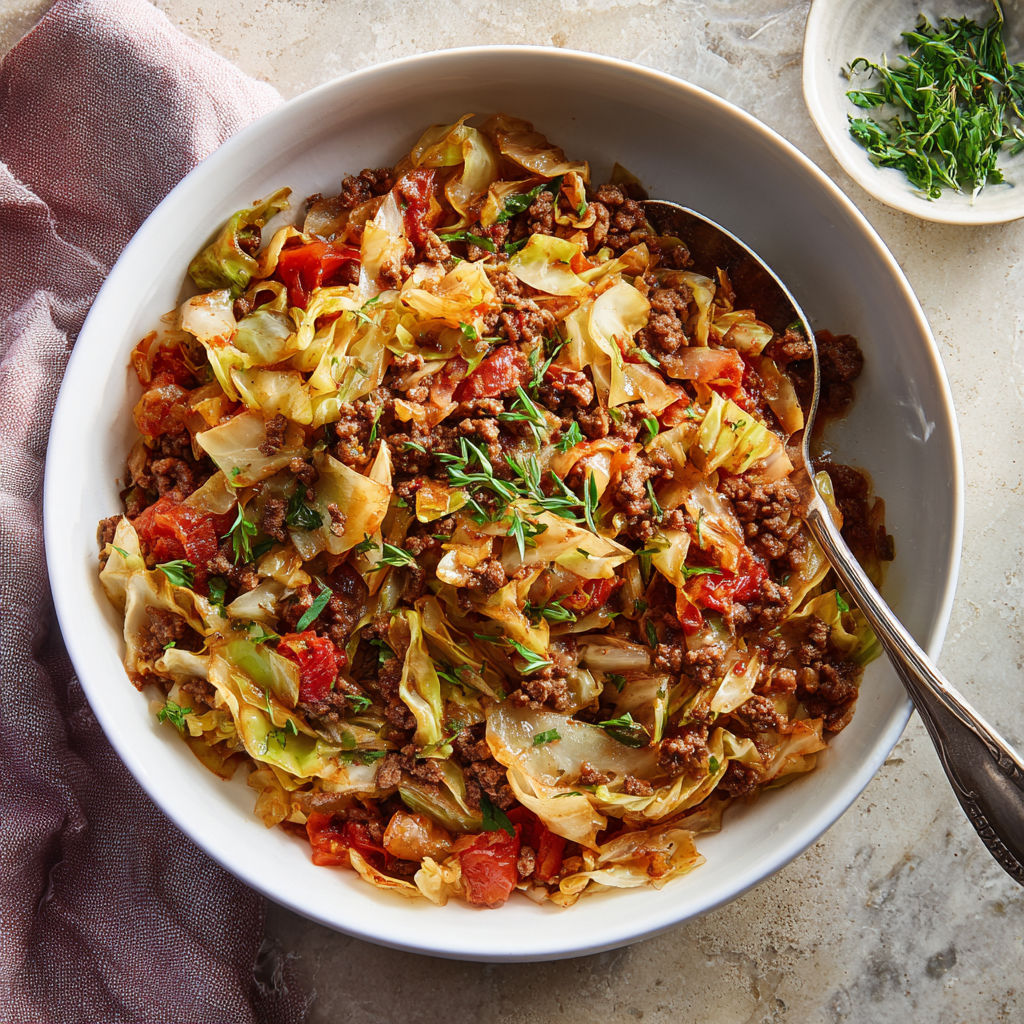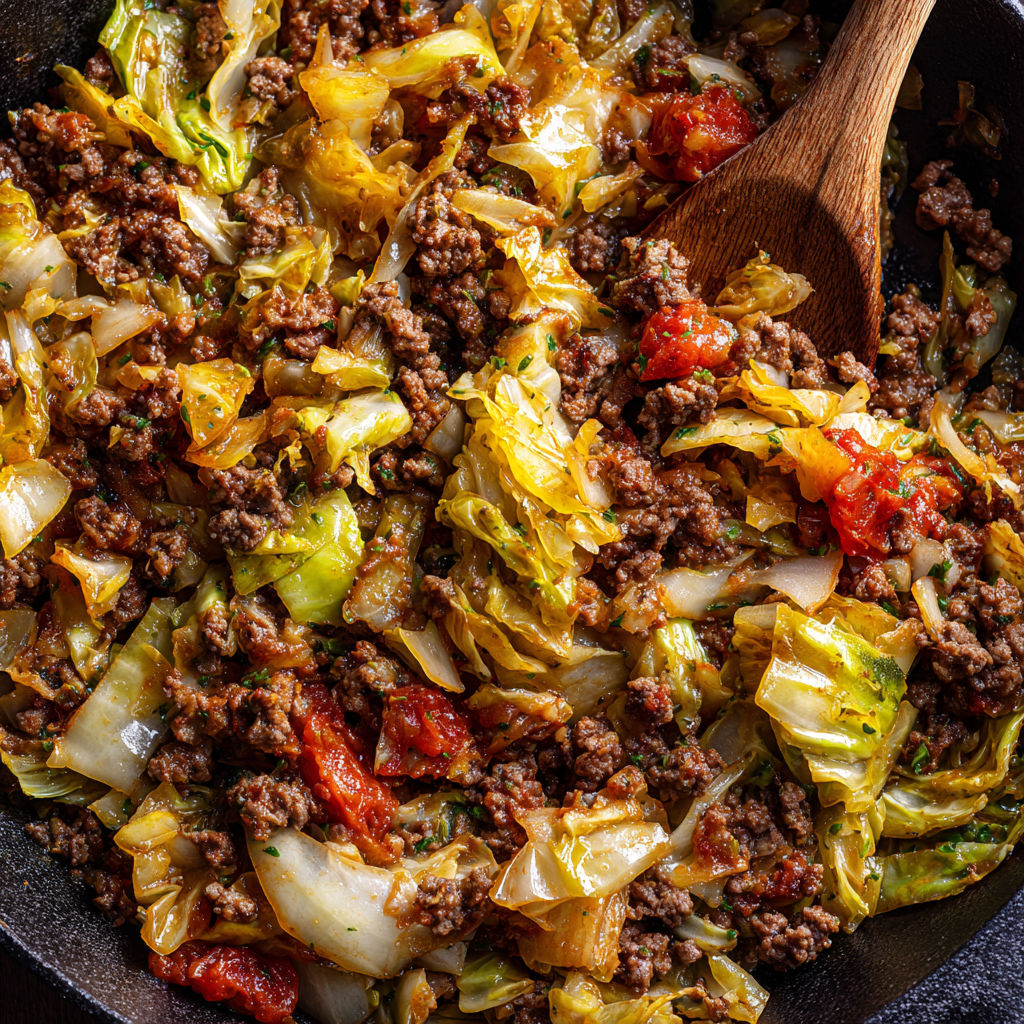 Save
Save Poêlée de Bœuf Haché et Chou is the kind of meal I turn to on busy nights when I want something nourishing and filling without spending hours in the kitchen. With just one skillet and a handful of simple ingredients, you get deep comfort and a satisfying mix of tender cabbage, savory beef, and a hint of tomato. It is hearty but never heavy. This is pure French comfort food at its easiest.
I first made this on a chilly evening when the fridge was nearly empty. It quickly became a repeat request because everyone loves it and it is endlessly adaptable.
Ingredients
- Ground beef: Choose lean or regular for flavor and look for bright red color with minimal browning
- Fresh cabbage: Green or savoy work best and should feel heavy and crisp without brown spots
- Yellow onion: Builds sweetness and flavor use ones that feel firm and have tight skin
- Garlic: Bring out the best by smashing fresh cloves and avoid any sprouting or soft bulbs
- Tomato sauce: Adds body and just the right amount of tang be sure to check for good quality with minimal added sugar
- Olive oil: For browning the beef and vegetables and adds flavor so use a good quality
- Salt and pepper: Simple but essential for bringing everything together look for fresh cracked pepper for best results
Instructions
- Prepare the Vegetables:
- Thinly slice the cabbage and onion and mince the garlic. Removing the thick cabbage core makes for more uniform cooking and keeps the dish tender throughout.
- Brown the Beef:
- Heat olive oil in a large skillet over medium high. Crumble in the ground beef and let it brown for at least five minutes without stirring too much. This allows flavorful browning to develop for depth.
- Sauté the Aromatics:
- Once beef is mostly browned, add onion and cook for three to four minutes until translucent. Add garlic and cook for one minute more until fragrant but not browned.
- Add Cabbage and Steam:
- Pile the sliced cabbage onto the skillet and sprinkle over salt and pepper. Cover and let it steam for about six minutes so the cabbage softens and shrinks down.
- Stir in Tomato Sauce:
- Pour in the tomato sauce and combine well. Reduce the heat to medium low, cover again, and simmer for ten to fifteen minutes until the cabbage is fully tender and flavors have melded.
- Finish and Serve:
- Taste for seasoning and give everything a final toss so the sauce coats the mixture evenly. Serve hot straight from the skillet with your favorite side or some crusty bread.
 Save
Save My personal highlight in this dish is the cabbage. When cooked down with beef and tomato, it turns silky sweet and picks up all the robust flavors from the pan. The first time I made this, everyone went back for seconds—even my picky eater.
Storage Tips
Store leftovers in an airtight container in the fridge for up to three days. Reheat gently in a skillet over medium heat until steaming. This dish also freezes very well portion out and freeze for up to two months then thaw in the fridge before reheating. I actually love the way the flavors deepen after a day or two in the fridge which makes it perfect for make ahead lunches.
Ingredient Substitutions
You can swap ground beef for ground turkey or chicken if you want something lighter. Savoy or Napa cabbage can be delightful alternatives to standard green cabbage. Tomato passata or even a mix with diced tomatoes works if you do not have plain tomato sauce. Add a pinch of smoked paprika or a dash of red pepper flakes if you like some extra warmth.
Serving Suggestions
This skillet meal stands alone but is great with a side of crusty French bread or steamed potatoes. For something fresh and crunchy, try a green salad with a mustardy vinaigrette. My family often tops this with a sprinkle of fresh herbs like parsley or chives for a burst of color and flavor.
Cultural Touchpoint
Poêlée dishes have deep roots in French everyday cooking. The word simply means cooked in a pan or skillet and usually signals an unfussy wholesome meal. It is the kind of food prepared after a long day in the fields or at work meant to stretch basic ingredients and fill hungry bellies with something warm and good.
Seasonal Adaptations
Shred in some carrots with your cabbage for added sweetness in fall or winter. Use purple cabbage for a pop of color in spring. Swap the tomato sauce for diced fresh tomatoes when they are at their summer peak. This dish is a blank canvas so feel free to let seasonal produce inspire each variation. I often add thin slices of leftover bell pepper for a touch of sweetness and color.
Success Stories
After sharing this recipe with a friend who had never tried cooked cabbage before she now makes it for her family every week. She loves how it reminds her of her grandmother’s rustic dishes even though it is so quick to pull together. It is amazing how much comfort you can get from a simple skillet meal.
Freezer Meal Conversion
Let the dish cool completely before packing into freezer safe containers. Label with the name and date and lay flat for easier stacking. To reheat gently warm in a skillet or microwave while stirring occasionally. The texture holds up especially well after freezing and quick reheating.
 Save
Save There is so much joy in seeing a humble skillet meal become a household favorite. I keep coming back to this recipe and love that you can make it your own with whatever you have on hand.
Recipe FAQs
- → What type of cabbage is best for this dish?
Green or savoy cabbage works well for sautéing, as they provide texture and a mild flavor that pairs with the beef.
- → Can I use a different meat?
Yes, ground turkey, chicken, or pork can be substituted for beef, allowing for a lighter or different flavor profile.
- → How do I store leftovers?
Allow the dish to cool, then store in an airtight container in the refrigerator for up to three days. Reheat gently before serving.
- → What sides go well with this meal?
It's delicious with crusty bread, steamed rice, or mashed potatoes to soak up the savory sauce.
- → Is this meal suitable for freezing?
Yes, it freezes well. Cool completely, portion into containers, and freeze for up to two months. Defrost before reheating.